Food processors are handy small appliances that assist the home cook or professional with a multitude of functions. Slicing, chopping, mincing, pureeing, and even kneading doughs. But are these handy appliances prone to overheating if run for too long? Is the risk of overheating a potential issue every time the appliance is used? We've researched these questions and have found substantial answers for you.
Any brand or model of food processor could overheat if:
- The bowl is misaligned at the base.
- The bowl is filled past capacity.
- It is used to process liquid foods.
- It is left to run unsupervised for several minutes.
Also, if the cook fails to use the "pulse" feature to help break the foods down, it could cause the processor to overheat and shut off automatically within minutes.
Are you interested in learning more about food processors? Eager for suggestions regarding how to avoid overheating your food processor? Perhaps you would like to learn how to load a food processor properly? Please continue reading; we have helpful food processor ownership advice to share with you!
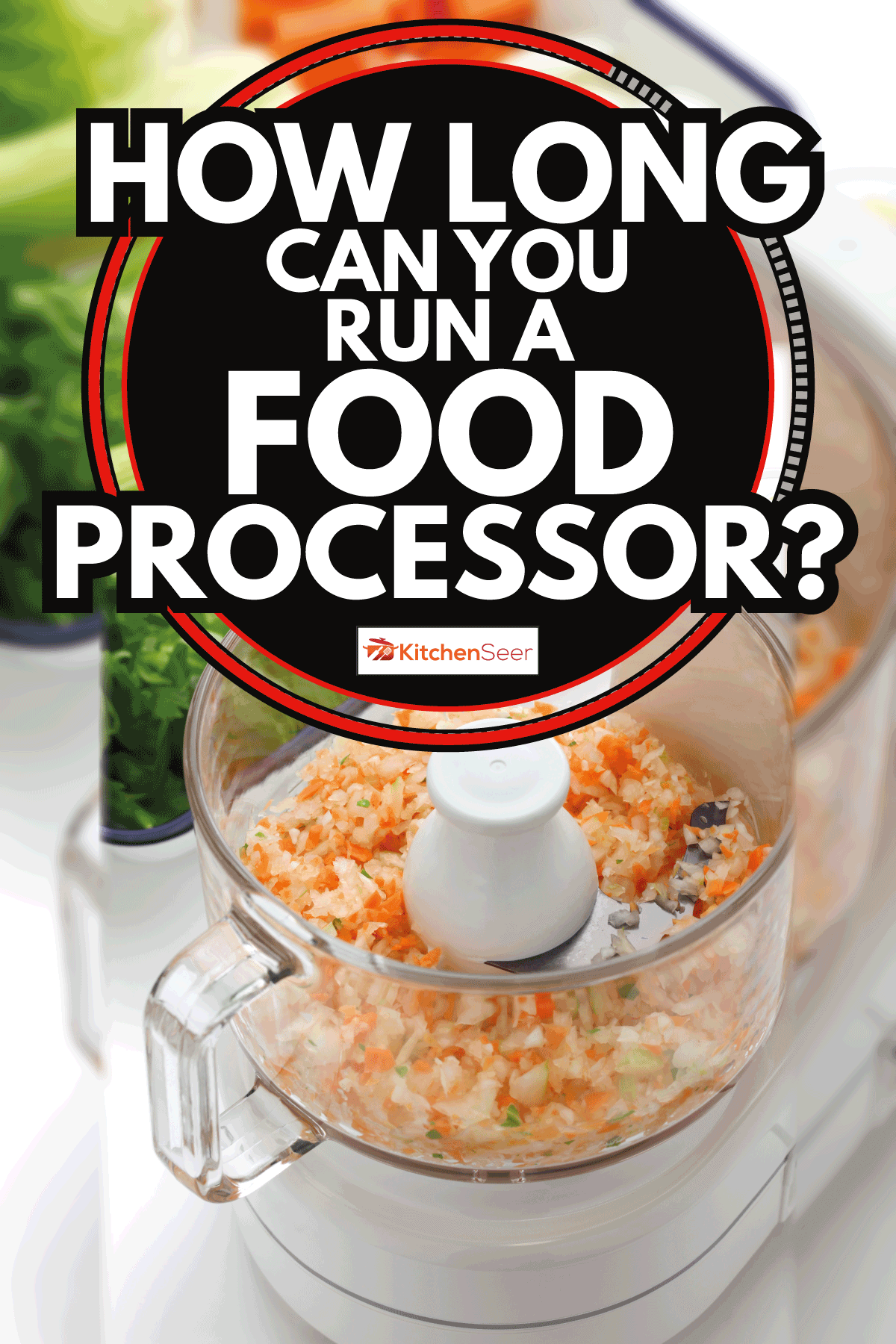
Can A Food Processor Overheat?
Generally, most food processor brands have designed models with an overheat protection sensor that will automatically turn the food processer off if the motor detects a sudden temperature rise. The overheat protection sensor doesn't allow the processor to overheat. Rather, it stops the motor when the temperatures start rising to avoid damage to the motor.
In the event that the food processer shuts itself off, refer to the owner's manual for how long to wait before turning the food processor on again. Usually, it takes roughly 30 minutes to completely cool before the processor is ready to dice and slice again.
What to do if the motor overheats
Unplug it from the outlet and let the food processor rest for 20-30 minutes to cool completely. Remove the working bowl, and feel the base to determine if it is still hot or warm to the touch after 30 minutes have passed.
If the base is cool, reattach the working bowl to the base and plug the processor in. If overheating was the issue, following these simple steps should remedy the problem. And if not, contact the manufacturers' customer service department for further instructions.
How Full Can You Fill A Food Processor?
Overfilling a food processor's bowl is the quickest path to either the processor malfunctioning or overheating. The best way to avoid these potential issues is to only fill the bowl half to three-quarters full. Doing so will prevent the blades from burning out, and you will avoid excess food particles leaking out of the bowl or feeding tube.
Suppose you are pureeing berries or vegetables for soups. Only fill the bowl to the top of the blades to prevent the liquids released from the foods from slushing out of the bowl or feeding tube. Also, scrape the sides of the bowls with a small spatula as needed between pulsing the processor. Click here to view a BPA-free spatula at Amazon.
Did you know that there are 11 different types of food processor blades available, and each offers busy cooks unique features! Click here to view our article about this intriguing topic.
What Should You Not Put In A Food Processor?
- Gelatins
- Meat cuts containing gristles
- Baked/hot nuts
- Bones
- Fruit peelings
- Hot liquids
According to Bon Appetit, it is wisest to avoid processing hot or excessive liquidy ingredients in the food processor. The reason is that the liquids could leak out of the sides of the bowl and potentially leak into the base of the liquid is allowed to steep into the food processers motor.
If the working bowl is made from plastic, the heat from the food could allow micro-plastic particles to leach into your food. Consuming plastic is quite hazardous to human health and should be avoided. Also, hot foods could melt the bowl and harm the motor with excessive heat levels. High heats are one of the most common causes for small appliance motors to overheat and fail.
Consider purchasing a food processor with a glass or BPA-free working bowl to reduce exposure to plastic particles. Click here to view BPA-free Cuisinart Food Processor at Amazon.
Interested in learning more about temperatures and food processors? Click here to read our article addressing those topics in particular.
How Do You Load A Food Processor?
According to KitchenAid, the steps for loading a food processor should always follow this order for injury-free and successful usage.
- First and foremost, ensure that your food processor is sitting on a clean and flat surface like a kitchen countertop or table.
- Next, attach the mixing/working bowl. Do listen to hear the bowl click into place to avoid it moving, or the processor will not turn on if the working bowl is not aligned properly.
- Insert the drive adapter in the middle of the work bowl and attach the blades/discs to the processor. Then, select the blade or disc that is best for the type of foods you are going to process. If unsure which one to use, refer to your owner's manual or choose the multipurpose "S" blade. Those blades are designed to process most types of foods without issues.
- After attaching the blades, place the working bowl's plastic cover onto the bowl, turn until it clicks into place. Moreover, there are models with a plastic cover attached to the working bowl. If your model has this feature, close the cover, it will snap, securing it into place.
Now the fun begins! Open the plastic cover to place food inside or pour it through the feeding tube. Only fill the working bowl halfway for even processing and to avoid overworking the blades. Start with tapping the pulse button twice or three times to ensure the foods are sufficiently broken down before using the other processing settings.
Click here to view the KitchenAid food processor on Amazon.
Suggestions for food processor maintenance
Always wash the blades, cover, and working bowl after each use. Never put the blades in the dishwasher; it will dull and discolor the blades. Instead, wash the blades by hand with dish soap and warm water and dry with a terry cloth kitchen towel.
Remove any large pieces of food debris from the working bowl with a spatula. Then fill the bowl halfway with water and add one or two drops of dish soap. Place the bowl back on the processer and pulse two or three times to clean the bowl. Detach the bowl from the motor base and thoroughly rinse with warm water. If bits of food debris get caught inside the blades or handles, use a small scrub brush or a toothbrush with a drop of dish soap to remove those stubborn bits.
On occasion, the working bowl emits an unpleasant odor, or there are visible stains from many uses. One method of remedying these issues is to soak the blades, bowl, and plastic lid in water for 10-15 minutes in a solution of one part baking soda and water. Remove the parts from the solution and rinse thoroughly with warm water to remove the baking soda. Allow the parts to air dry in a dish rack or dry by hand before reassembling the components.
Storing your food processor properly is an important part of maintenance. Consider placing a dust cover over the food processor to protect it from dust particles and scratches. Also, the added protection the dust cover provides will help extend the working life of your small appliance.
Click here to view a food processor dust cover designed to fit most brands at Amazon.
Safety considerations for operating a food processor
- Don't wear loose-fitting clothes while operating the food processor.
- Keep hair tied back or tuck it under a cap.
- Never wear a tie or long necklace.
- Keep small children and pets out of the kitchen while using the food processor.
- Do not leave the food processor plugged in unattended.
- Keep the cord away from stovetops or other hot surfaces.
- Do not allow the processor to sit near any standing water.
- Wear cut gloves when washing or handling the blades.
Click here to view quality cut gloves at Amazon.
In closing
Food processors are multipurpose appliances that handle chopping, mincing, slicing, and an array of other physically demanding tasks--while you, the cook, concentrate on what truly matters in the kitchen. Your splendid culinary creations! We hope this article has helped you gain knowledge that will help you feel more comfortable while operating your food processor. Please visit Kitchenseer.com soon for more factual and inspiring culinary content!






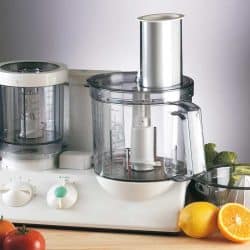
![Food processor in kitchen table top, How Loud Is A Food Processor? [With Tips On How To Choose A Quiet One!]](https://kitchenseer.com/wp-content/uploads/2021/08/Food-processor-in-kitchen-table-top-250x250.jpg)
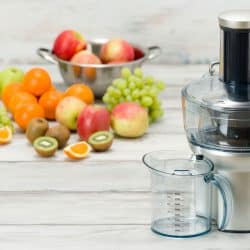
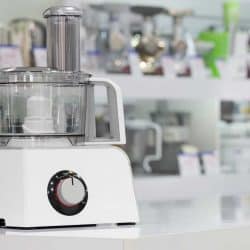
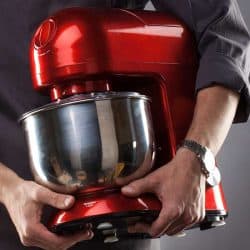
![Food processor blender or coffee grinder blades on wooden table, What Are The Parts Of A Food Processor? [5 Main Sections]](https://kitchenseer.com/wp-content/uploads/2020/10/Food-processor-blender-or-coffee-grinder-blades-on-wooden-table-250x250.jpg)